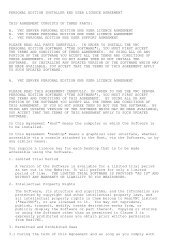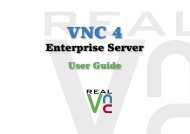VNC User Guide - RealVNC
VNC User Guide - RealVNC
VNC User Guide - RealVNC
You also want an ePaper? Increase the reach of your titles
YUMPU automatically turns print PDFs into web optimized ePapers that Google loves.
Chapter 2: Getting Connected<br />
c. Click the Start button. Real<strong>VNC</strong> attempts to contact the host computer over the Internet. Providing<br />
the host computer is connected to the Internet, the network address of an intermediary device is<br />
revealed:<br />
<strong>VNC</strong> Server appears to be behind a NAT router with IP address 212.44.6.81.<br />
You will need to configure that router to forward port 5900 to this<br />
computer before you can connect to <strong>VNC</strong> Server over the Internet.<br />
Configuring a router to forward network communications<br />
In a typical home or small office environment, a router assigns a private network address to an internal<br />
computer. You should also be aware that <strong>VNC</strong> Server listens for network communications on a particular<br />
port. The router must be configured to forward communications from <strong>VNC</strong> Viewer to the correct port at the<br />
correct private network address. This procedure is known as port forwarding.<br />
Note: Port forwarding instructions are specific to routers. If you do not have access to the host computer,<br />
ask a host computer user to consult the manufacturer’s documentation, or visit www.portforward.com.<br />
Note that a router may act as a public interface to more than one computer in a home or small office<br />
environment. If you want to connect to multiple host computers, then <strong>VNC</strong> Server must be running on each<br />
and listening on a different port. The router must be configured to distinguish between host computers using<br />
port numbers.<br />
Consider the following example:<br />
A. Router with a network address assigned by an ISP, for example 212.44.6.81. B. Host computer with a network<br />
address assigned by the router, for example 192.168.0.1. <strong>VNC</strong> Server is listening on the default port, 5900. C. Host<br />
computer with a network address assigned by the router, for example 192.168.0.2. <strong>VNC</strong> Server has been configured to<br />
listen on port 5901. D. Client computer running <strong>VNC</strong> Viewer.<br />
<strong>VNC</strong> <strong>User</strong> <strong>Guide</strong> 29
















